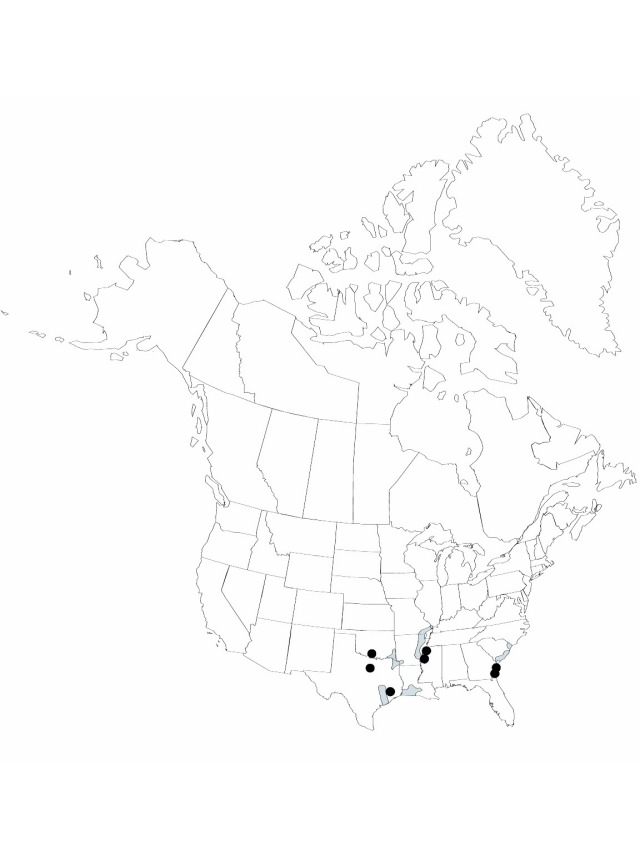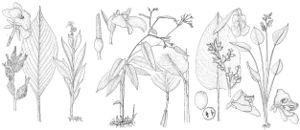Difference between revisions of "Thalia dealbata"
Thalia dealbata [plate]. 1794.
FNA>Volume Importer |
FNA>Volume Importer |
||
| Line 26: | Line 26: | ||
|habitat=Coastal plain in swamps, streamsides, roadside ditches, and ponds | |habitat=Coastal plain in swamps, streamsides, roadside ditches, and ponds | ||
|distribution=Ark.;Ga.;Ill.;La.;Miss.;Mo.;Okla.;S.C.;Tex. | |distribution=Ark.;Ga.;Ill.;La.;Miss.;Mo.;Okla.;S.C.;Tex. | ||
| − | |discussion=<p>Thalia dealbata is the only species of Marantaceae endemic to North America and the only one not found in the tropics. Its sister species, T. multiflora Horkel ex Körnicke, is similarly restricted, but to the southernmost part of the range, southern Brazsil to Uruguay. It is possible that our species is the result of an early, chance long-distance dispersal event from a South American population. This might partially explain why the plants are autogamous in spite of the elaborate floral mechanism.</p><!-- | + | |discussion=<p><i>Thalia dealbata</i> is the only species of Marantaceae endemic to North America and the only one not found in the tropics. Its sister species, T. multiflora Horkel ex Körnicke, is similarly restricted, but to the southernmost part of the range, southern Brazsil to Uruguay. It is possible that our species is the result of an early, chance long-distance dispersal event from a South American population. This might partially explain why the plants are autogamous in spite of the elaborate floral mechanism.</p><!-- |
| − | --><p>Thalia dealbata is grown as an ornamental in tropical and temperate gardens and is hardy as far north as Philadelphia, Pennsylvania, and Vancouver, British Columbia when the rhizome is submersed during winter.</p> | + | --><p><i>Thalia dealbata</i> is grown as an ornamental in tropical and temperate gardens and is hardy as far north as Philadelphia, Pennsylvania, and Vancouver, British Columbia when the rhizome is submersed during winter.</p> |
|tables= | |tables= | ||
|references={{Treatment/Reference | |references={{Treatment/Reference | ||
| Line 86: | Line 86: | ||
|publication year=1794 | |publication year=1794 | ||
|special status= | |special status= | ||
| − | |source xml=https://jpend@bitbucket.org/aafc-mbb/fna-data-curation.git/src/ | + | |source xml=https://jpend@bitbucket.org/aafc-mbb/fna-data-curation.git/src/8f726806613d60c220dc4493de13607dd3150896/coarse_grained_fna_xml/V22/V22_70.xml |
|genus=Thalia | |genus=Thalia | ||
|species=Thalia dealbata | |species=Thalia dealbata | ||
Revision as of 16:00, 18 September 2019
Plants 0.7–2.5 m. Leaves: basal 2–5, cauline 0; sheath pruinose, glabrous; petiole pruinose, glabrous; pulvinus yellowish brown to red or purple-brown, 0.6–2.5 cm, glabrous; blade ovate, occasionally narrowly elliptic, 17–55 × 7–22 cm, firm, stiff-papery, base rounded, rarely obtuse, apex acuminate, abaxial surface pruinose, appearing whitish, glabrous, adaxial surface pilose to nearly villous in basal 0.5–1 cm of blade, including midrib, at apex, and along margin of broader side. Inflorescences erect, tightly clustered, compact array, 9–31 × 7–18 cm; scapes 0.5–1.9 m; rachis pruinose; internodes 2–3 mm; bracts markedly pruinose, appearing whitish, red-brown to red-purple beneath waxy coating, orbiculate, strongly cupped, 0.8–1.5 cm, stiff, leathery, glabrous. Flowers: sepals 1.5–2.5 mm; outer staminode dark purple, 12–15 × ca. 6 mm; callose staminode base white to pale purple, margins and apex dark purple, apical rim reduced, petal-like. Fruits nearly globose to broadly obovoid, 9–12 × 8–11 mm. Seeds dark brown to black, nearly globose to broadly ellipsoid, 8–10 × 7–9. 2n = 12 (in cultivation).
Phenology: Flowering late spring–early fall (May–Sep); fruiting summer–fall (Jun–Oct).
Habitat: Coastal plain in swamps, streamsides, roadside ditches, and ponds
Distribution

Ark., Ga., Ill., La., Miss., Mo., Okla., S.C., Tex.
Discussion
Thalia dealbata is the only species of Marantaceae endemic to North America and the only one not found in the tropics. Its sister species, T. multiflora Horkel ex Körnicke, is similarly restricted, but to the southernmost part of the range, southern Brazsil to Uruguay. It is possible that our species is the result of an early, chance long-distance dispersal event from a South American population. This might partially explain why the plants are autogamous in spite of the elaborate floral mechanism.
Thalia dealbata is grown as an ornamental in tropical and temperate gardens and is hardy as far north as Philadelphia, Pennsylvania, and Vancouver, British Columbia when the rhizome is submersed during winter.
